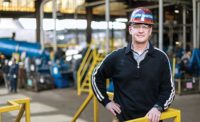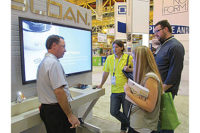Plumbing Industry Still Awaits Recovery
Panel of manufacturers examines economy, government and green buildings.

The stagnant housing market, a more combative federal government and green building opportunities were among the topics addressed Sept. 19 during an Executive Roundtable at the Plumbing Manufacturers International’s Fall Meeting in Washington. Political pundit George Will moderated the panel, whose members represented American Standard, Delta Faucet, Elkay, Kohler, Moen, Symmons and TOTO.
The economy dominated the manufacturers’ remarks either directly or when commenting on other issues. Moen President David Lingafelter said he saw the housing spigot start to turn off as early as Oct. 4, 2006.
“We’ve been adjusting since 2007 to start to make decisions based on the new normal,” he said. “We focus on what consumers are buying.”
Jim Westdorp, group president – Kitchen & Bath of Kohler Co., said he’s an optimist but sees nothing to suggest the housing market would pick up any time soon. William Strang, senior vice president of operations for TOTO USA, said he doesn’t expect housing starts to reach 800,000 to 900,000 for another four or five years.
“The recession did not end in our industry in 2009,” Elkay President and CEO Tim Jahnke said. “We have to realize we’re several years away until we reach the housing starts we’ve seen in the past.
“How do you design your business around the new normal? If you don’t change everything you do every 36 months, you’re probably falling behind. The biggest risk is if the industry is changing faster than you are.”
Delta Faucet President Keith Allman said he doesn’t expect to see an economic turnaround before the next election. In the meantime, manufacturing will be a balancing act between keeping up production and eliminating waste.
Allman and other panelists said their companies are finding ways to become more efficient and innovative. In these ways, they can capitalize on the recovery when it eventually happens.
Symmons CEO Tim O’Keeffe added: “It’s been tough sledding. The efficiencies we are putting into our businesses are paying off, but at the end of the day, we depend on people purchasing our products.”

Along with the sluggish housing market, repair and remodeling work has dipped, Allman said. Of the work going on, more of it is flowing to retail and DIY segments.
Lingafelter quoted an industry figure that repair and remodeling make up more than 70% of residential construction activity. Much of that work is in repairs, he added, or homeowners doing smaller remodeling jobs.
People are doing more minimal home improvements today than before, Jahnke said. Strang agreed.
“They’re making much more cost-conscious renovations along with improvements that will allow them to stay in their homes longer,” he said.
Only 48 million people are following 78 million baby boomers, many of whom won’t be able to sell their houses, Devine said. They will be forced to fix their homes and buy products that will allow them to age in place.
Another driver of remodeling and repair work is the aging of country’s housing stock, Jahnke said.

But not at an extra cost, he added. A very small price margin pushes consumers off green products, unless they see a discernible benefit in purchasing the more sustainable technology.
The manufacturers expressed concern that states, rather than the federal government, now can dictate how much water their plumbing products use.
“I would drive for a national standard on water conservation with the EPA leading the way,” Allman said. “A basic level should be required. Then if an individual municipality or state has lower requirements, we can decide whether to enter that market.”
The manufacturers generally gave high marks to EPA’s voluntary WaterSense program, which allows them to put a WaterSense label on their water-efficient products.
“WaterSense did a fantastic job of creating a collaborative effort between EPA and all stakeholders to drive water conservation,” Strang said. “It’s the kind of collaboration we need to do with other areas.”
“In the past 15 years, we’ve experienced a reasonable relationship between OSHA and manufacturing to move forward,” Jahnke said. “Now, in the last three years, more audits are going on and it is becoming a burden.
“The present administration has declared war on manufacturing. We manufacture in the United States and will continue to do so. But it makes you sit back and wonder why sometimes.”
The view in today’s world divides good manufacturing and bad manufacturing, Devine said. Green manufacturing processes are perceived more favorably than older, smokestack-style industries.
“The No. 1 thing people on Capitol Hill should know about your business is how precarious manufacturing is in the United States today,” Westdorp said. “Facilities are very close to the edge and could close up or go elsewhere.”
Another issue confounding manufacturers relates to employees. Lingafelter said his company can get workers, although it may take longer to find them.
“We find it takes four years of training once a student graduates from a technical school,” O’Keeffe said.
Devine added: “There’s a clear shortage of people with technical or engineering degrees. We’re producing more people with soft education than hard degrees.”
Ending the discussion on a positive note, Jahnke pointed to a growing middle class.
“Worldwide, 50 to 70 million people will be coming out of poverty with some level of disposable income. How do we get our products in the hands of these people? There are huge opportunities on the positive side, but they are unlike anything we have experienced in the last 20 years.”

Political
pundit George Will (far right) moderates a discussion among plumbing company executives.
Photos by Bob Miodonski.
The stagnant housing market, a more combative federal government and green building opportunities were among the topics addressed Sept. 19 during an Executive Roundtable at the Plumbing Manufacturers International’s Fall Meeting in Washington. Political pundit George Will moderated the panel, whose members represented American Standard, Delta Faucet, Elkay, Kohler, Moen, Symmons and TOTO.
The economy dominated the manufacturers’ remarks either directly or when commenting on other issues. Moen President David Lingafelter said he saw the housing spigot start to turn off as early as Oct. 4, 2006.
“We’ve been adjusting since 2007 to start to make decisions based on the new normal,” he said. “We focus on what consumers are buying.”
Jim Westdorp, group president – Kitchen & Bath of Kohler Co., said he’s an optimist but sees nothing to suggest the housing market would pick up any time soon. William Strang, senior vice president of operations for TOTO USA, said he doesn’t expect housing starts to reach 800,000 to 900,000 for another four or five years.
“The recession did not end in our industry in 2009,” Elkay President and CEO Tim Jahnke said. “We have to realize we’re several years away until we reach the housing starts we’ve seen in the past.
“How do you design your business around the new normal? If you don’t change everything you do every 36 months, you’re probably falling behind. The biggest risk is if the industry is changing faster than you are.”
Delta Faucet President Keith Allman said he doesn’t expect to see an economic turnaround before the next election. In the meantime, manufacturing will be a balancing act between keeping up production and eliminating waste.
Allman and other panelists said their companies are finding ways to become more efficient and innovative. In these ways, they can capitalize on the recovery when it eventually happens.
Symmons CEO Tim O’Keeffe added: “It’s been tough sledding. The efficiencies we are putting into our businesses are paying off, but at the end of the day, we depend on people purchasing our products.”

Elkay’s
Tim Jahnke (right) makes a point as Moen’s David Lingafelter (left) and Kohler’s
Jim Westdorp listen.
Repair/Remodel trends
American Standard Brands CEO Don Devine said housing statistics are an outcome of other factors such as employment and job security. The country should focus on employment as a way to improve the economy overall.Along with the sluggish housing market, repair and remodeling work has dipped, Allman said. Of the work going on, more of it is flowing to retail and DIY segments.
Lingafelter quoted an industry figure that repair and remodeling make up more than 70% of residential construction activity. Much of that work is in repairs, he added, or homeowners doing smaller remodeling jobs.
People are doing more minimal home improvements today than before, Jahnke said. Strang agreed.
“They’re making much more cost-conscious renovations along with improvements that will allow them to stay in their homes longer,” he said.
Only 48 million people are following 78 million baby boomers, many of whom won’t be able to sell their houses, Devine said. They will be forced to fix their homes and buy products that will allow them to age in place.
Another driver of remodeling and repair work is the aging of country’s housing stock, Jahnke said.

TOTO’s William Strang (right) shares a light moment with Elkay’s Tim
Jahnke.
Green Issues
A high percentage of consumers are green conscious with younger generations likely to spend more than older homeowners on sustainable products, Lingafelter said. As young consumers engage more in the housing market, they will demand more green plumbing products.But not at an extra cost, he added. A very small price margin pushes consumers off green products, unless they see a discernible benefit in purchasing the more sustainable technology.
The manufacturers expressed concern that states, rather than the federal government, now can dictate how much water their plumbing products use.
“I would drive for a national standard on water conservation with the EPA leading the way,” Allman said. “A basic level should be required. Then if an individual municipality or state has lower requirements, we can decide whether to enter that market.”
The manufacturers generally gave high marks to EPA’s voluntary WaterSense program, which allows them to put a WaterSense label on their water-efficient products.
“WaterSense did a fantastic job of creating a collaborative effort between EPA and all stakeholders to drive water conservation,” Strang said. “It’s the kind of collaboration we need to do with other areas.”
Government Attack
WaterSense was just about the only thing related to the government that did earn the panel’s praise. Manufacturers were far less positive about what they see as a changing attitude in Washington.“In the past 15 years, we’ve experienced a reasonable relationship between OSHA and manufacturing to move forward,” Jahnke said. “Now, in the last three years, more audits are going on and it is becoming a burden.
“The present administration has declared war on manufacturing. We manufacture in the United States and will continue to do so. But it makes you sit back and wonder why sometimes.”
The view in today’s world divides good manufacturing and bad manufacturing, Devine said. Green manufacturing processes are perceived more favorably than older, smokestack-style industries.
“The No. 1 thing people on Capitol Hill should know about your business is how precarious manufacturing is in the United States today,” Westdorp said. “Facilities are very close to the edge and could close up or go elsewhere.”
Another issue confounding manufacturers relates to employees. Lingafelter said his company can get workers, although it may take longer to find them.
“We find it takes four years of training once a student graduates from a technical school,” O’Keeffe said.
Devine added: “There’s a clear shortage of people with technical or engineering degrees. We’re producing more people with soft education than hard degrees.”
Ending the discussion on a positive note, Jahnke pointed to a growing middle class.
“Worldwide, 50 to 70 million people will be coming out of poverty with some level of disposable income. How do we get our products in the hands of these people? There are huge opportunities on the positive side, but they are unlike anything we have experienced in the last 20 years.”
Links
Looking for a reprint of this article?
From high-res PDFs to custom plaques, order your copy today!





